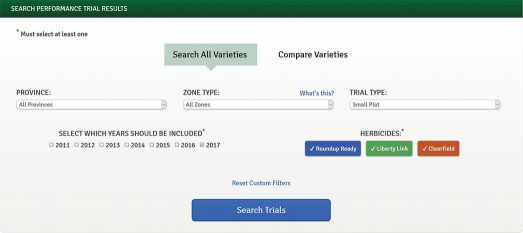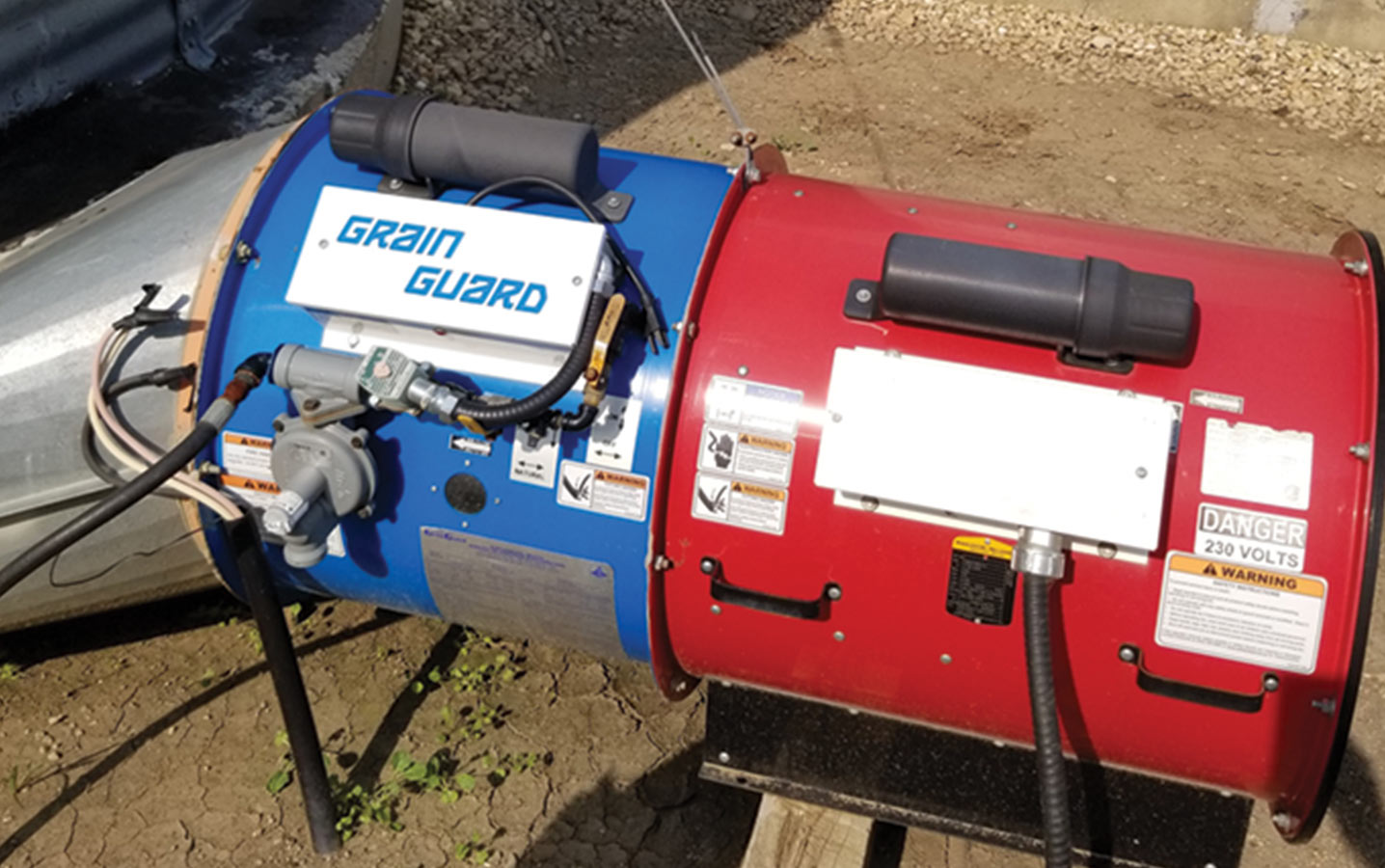Agronomy Insights
Adding heat to aeration systems
Canola stored tough or damp is at higher risk for spoilage. ‘Tough’ is moisture between 10 and 12.5 per cent. ‘Damp’ is anything above that. With cool temperatures this time of year, natural air blown through the aeration system will not do much if any drying. Heat must be added. Talk to your fan company about systems they have to add heat to fans and whether electricity or gas power is right for you.
Joy Agnew, a grain storage researcher with Prairie Agricultural Machinery Institute (PAMI) in Humboldt, Sask., has these recommendations to improve results and reduce risk when using supplemental heat:
Heat air to at least 10°C. Air warmer than 10°C will dry grain faster, but in cold conditions, don’t heat incoming air above 20°C. This minimizes the risk of condensation and freezing at the edge of the bin, Agnew says.
Use a fan that provides airflow of at least 0.5 cubic feet per minute (cfm) per bushel. While airflow of 0.1 to 0.2 cfm/bu. is adequate to cool a bin of canola, more airflow is needed with heated air.
Under-fill the bin to improve airflow. The greater the depth of canola in the bin, the more fan capacity you will need to move air through it effectively. Insufficient air flow can result in a high moisture zone near the top of the bin that can initiate spoilage. PAMI research found with very large bins (25,000) filled full of canola, the fan could not physically push air through the grain mass at all. Grain had to be removed.
Ventilate the bin. Proper ventilation at the top of the bin to allow for escape of the warm moist air is very important, especially for large bins and especially when adding supplemental heat since the moisture removal rate is so much higher when heat is added.
Turn the bulk frequently. Remove at least one third out the bottom and auger it back on top. This evens out any areas where airflow might have been inadequate and gives you a chance to check the grain.
Monitor regularly. This is good advice for all canola. Be extra careful with canola that goes into the bin warm and tough this week.
For more details, read “Tips for drying tough or damp canola” and “Storage: Fan limitations in large bins” at canolawatch.org.
How much fertilizer does canola need?
November could be a good time to do soil tests if the ground isn’t frozen. With fall soil test results in hand, farmers and agronomists can check the raw numbers and do their own fertilizer-rate calculations. The following describes the macronutrient requirements for canola.
Nitrogen. The Canadian Fertilizer Institute factsheet, “Nutrient Uptake and Removal by Field Crops,” produced in 2001, says nitrogen uptake for a 35 bu./ac. canola crop is 100-123 lb./ac. of actual N. That works out to 2.9 to 3.5 pounds of available N per bushel of seed yield. In a study published in 2005, Rigas Karamanos found that with higher yields (say 50 bu./ac. or more), nitrogen uptake for hybrids was as low as 2.1 lb./bu. He says an appropriate updated range for nitrogen uptake is 2 to 3 pounds of available N per bushel of seed yield. Not all of that will have to be applied as fertilizer. Some will come from soil reserves. Soil tests will indicate soil reserves, but available carryover nitrogen can be difficult to predict. Often about half the soil test N is immobilized and not available to this year’s crop. And some will come from mineralization of soil organic matter (OM), but the amount varies widely based on soil type, soil OM levels and moisture. In general, OM can generate 6 to 30 pounds of available nitrogen per acre for each percentage point of OM.
Phosphorus. Canola takes up 1.25 to 1.5 lb./ac. of phosphate (P2O5). A 50 bu./ac. canola crop would therefore need 62.5 to 75 lb./ac. of available phosphate. If soil tests show available P levels at less than 10 parts per million (20 lb./ac.), this is considered “low” and growers may want to use a rate higher than crop removal to build soil reserves. At a soil test of 10-20 ppm, rates that match removal are recommended. For a 50 bu./ac. canola crop, the “removal” rate would be over 40 lb./ac. of phosphate (80 lb./ac. of MAP, for example). Of that, a safe seed-placed rate of 20 lb./ac. of phosphate will ensure that canola has access to phosphate fertilizer and the benefit of early pop up, which is especially important when seeding into cool soils with low P levels, into soils with pH outside the sweet spot of 6.5-7, and in short-season areas. The rest can go with the nitrogen blend placed outside the seed row, ideally in a band.
Sulphur. Canola needs 0.5 to 0.8 pounds of sulphur (S) per bushel of yield, making it a high S-using crop. A 50 bu./ac. canola crop needs 30 to 40 lb./ac. of available S. A fair estimation of soil reserves is not always possible with a soil test because S is often highly variable across a field. If soil is low in S, fertilize according to soil test recommendations. If soil is moderate or high in S, farmers may want to include some S in the fertilizer blend – say 10-15 lb./ac. – to offset the high amount of S-test variability in a field.
Potassium. Canola plants need 2.3-2.5 pounds of potassium (K2O) for every bushel of seed yield. A 50 bu./ac. crop can take up 125 lb./ac. of available potassium. Canola is an excellent scavenger of potassium in the soil and because the relatively ‘young’ Prairie soils continue to produce plant-available potassium through the break-down of clay minerals, canola crops have rarely shown a response to potassium fertilizer. But if soil tests show less than 250 pounds per acre (125 ppm), canola may benefit from an application.
For more on macronutrient and micronutrients needs for canola, as well as application and product guidelines, see the Fertilizer Management chapter of the Canola Encyclopedia at canolaencyclopedia.ca.
Compare varieties with the Canola Performance Trials online tool

Canola Performance Trials data for 2018 will be loaded soon at canolaperformancetrials.ca. Data from 2017 and earlier is available any time. Here are a few ways to use the online search tool, situated at the bottom of the CPT home page:
- Search by herbicide system. If you know which herbicide system you want to use, but haven’t picked a variety, start with ‘Search all varieties’ and use the filters to display data from your preferred herbicide tolerance (HT) system. After selecting the HT system of your choice, make any other filter selections you like (ex. small plot or field scale data) and then click the blue ‘Search trials’ button to view the graphed results.
- Search by yield and maturity. To look for top-yielding varieties with the shortest maturity, choose your filters (ex. select short, mid or long season zone under ‘Zone type’), then click ‘Search trials’. Scroll below the graphed results to the ‘Trial results data’ table. Click ‘yield’ in the grey bar at the top of the table to sort by yield. Once you have that list, look at the top yielders to see which has the shortest days to maturity. Go back to check other years or refine the search by province or HT system.
- Compare varieties. If you’re concerned about clubroot, click ‘Compare varieties’ at the top, then choose ‘Show me all the data’ and pick up to three CR varieties at a time for head to head comparisons.
- Head to head results. To see how two varieties performed when together in the same location, click ‘Compare varieties’ at the top then choose ‘Head to head comparison’. Choose two varieties then ‘Search trials’. Note, this only includes data if the two varieties were grown at the same place and time (same site in the same year). That means fewer data points but a high quality comparison.
- Local results. To see data from trials closest to your location, run any search and scroll down to see the map. Zoom in on the responsive map and click on the marker closest to your location.
Driving agronomy forward
Members of the CCC agronomy team are active on various industry steering committees, providing leadership in advancing canola field management practices. The steering committees have three functions – prioritize research needed, develop key extension messaging and act as an expert group to provide leadership on the issue they represent. Here are the steering committees with CCC agronomy team involvement:
- Canola Performance Trial technical committee – since 2011
- Blackleg Steering Committee – since 2012
- Clubroot Steering Committee – since 2015
- Fertility Steering Committee – since 2018
- Sclerotinia Steering Committee – since 2018
- Lime Steering Committee – since 2018
Get to know your CCC Agronomy Team
Find the whole team at canolawatch.org/contact-us.
 Taryn Dickson
Taryn Dickson
Resource Manager
Contact: 204-982-2111
and dicksont@canolacouncil.org
Twitter: @DicksonCCC
 Warren Ward
Warren Ward
Agronomy specialist, Southeast Saskatchewan
Contact: 306-621-0630 and
wardw@canolacouncil.org
Twitter: @WardCCC
Specialty: Fertility
 Gregory Sekulic
Gregory Sekulic
Agronomy Specialist, Peace Region
Contact: 780-832-2382 and
sekulicg@canolacouncil.org
Twitter: @SekulicCCC
Specialty: Sustainability, pollinators and beneficials





